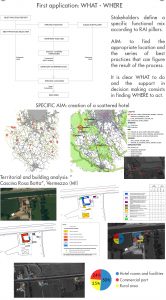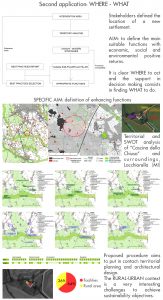Rural Architecture Urbanism
Rural Architectural Urbanism, that is a planning action, derives from Rural Architectural Intensification (RAI) that has been defined by the local research unit of the University of Pavia inside a general framework of a National Research Project (PRIN 2009). Authors from University of Pavia participated with the research theme: “Regeneration and renewal of rural landscape. Building strategies in the surroundings of new urban centers”.
The study of the rural and urban (and rurban) context in terms of regional planning and architecture highlights a complex and non-unified fabric formed by numerous and distinct elements (material and non-material). Mostly, settlements are located in juxtapositions, both at the micro level and at the territorial and regional level. Taking note of these characteristics, in a sustainable point of view the sensitivity, the conflicts and problems encountered in such a complex system, methodological and operational process to transform and regenerate the contemporary landscape must favor shapes and uses to improve social and economic situation. Rural-urban regeneration is not considered only as a series of punctual interventions aimed to improve some specific functions, maybe realized with wonderful and hyper-eco friendly architectural solutions.
Rural Architectural Intensification is an innovative design action for architecture and urban plan-ning. This operative action is applicable for regenerate and transforms the contemporary city-landscape into uses that are suitable for contemporary ways of living through the construction of a new paradigm that will shape an architectural and urban project committed to sustainability.
Rural Architectural Intensification has three keywords: Rural as environment with richness of history, values, memory and high quality; Architecture as a process and construction product, which can create social, cultural, economic and technological innovation; Intensification as a strategy to create sustainable density of activities and spaces for people in which the natural environment and the rural-urban environment coexist harmoniously.
Once “Intensification” is the main goal, new territorial functions must be considered into a systemic planning action. Of course, the sequence of steps comes from the typology of user (stakeholders, public bureaus and single private actors). The combination of a regional territory, a multiplicity of agents and economic interests, environmental issues connected to sustainable transformations, creates specific planning needs that must be studied together with the characteristics of the context.
Among all the possibilities, authors considered two main intervention typologies:
Stakeholders defined new functions and they have to find: the appropriate location, the appropriate anthropic weight of the new settlements, the series of best practices that can figure the result of the process. So: it is clear WHAT to do and the support in decision making consists in finding WHERE to act (Figure 1).
Stakeholders defined the location of new settlements is known and they have to find: which are the main suitable functions that have economic and environmental positive returns, dimensions of new settlements, connective systems and infrastructural needs, specific territorial sensibilities and induced pressure. So: it is clear WHERE stakeholders have to act and the support in decision making consists in finding WHAT to do (Figure 2).
Menu
Search
Last news
- Double Degree – Università di Pavia e Tongji University di Shanghai
- PREMIAZIONE CONCORSO: MODI E TEMPI DI FRUIZIONE IN OLTREPO’
- MODI E TEMPI DI FRUIZIONE IN OLTREPÒ: progetti di rilancio turistico e di vivibilità – Concorso di Idee
- Double Degree with Tongji University – Student’s Selection – NOW OPEN
- Premio di Laurea Ilaria Rambaldi
Archive
- Giugno 2024
- Ottobre 2021
- Giugno 2021
- Maggio 2021
- Novembre 2020
- Settembre 2020
- Luglio 2020
- Giugno 2020
- Aprile 2020
- Febbraio 2020
- Dicembre 2019
- Maggio 2019
- Febbraio 2017
- Dicembre 2015


